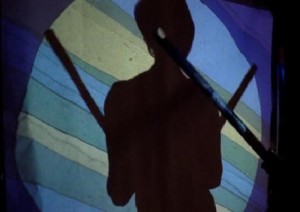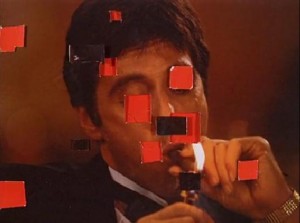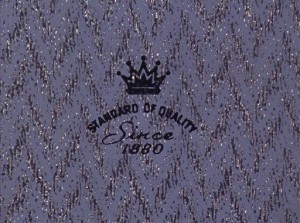 Jodie Mack: Let Your Light Shine (Jodie Mack, 2013, 74 min)
Jodie Mack: Let Your Light Shine (Jodie Mack, 2013, 74 min)
Wisconsin Film Festival, Sunday April 6, 7:00pm»
Running my fingers along the foil stamping of a hardcover book. The colorful glint of a prism refracting light through its smooth surface. The captivation at the images within a kaleidoscope. The touch of matte and glossy paper alike as I roll up one of my many movie posters.
These are all sensations and experiences that resonate strongly with me in both the past and the present, and they are all on distinctive display in a program of Jodie Mack’s work, including: Dusty Stacks of Mom: The Poster Project (41 min), Glistening Thrills (8 min), Let Your Light Shine (3 min), New Fancy Foils (12 min), and Undertone Overture (11 min). One of the experimental programs at the Wisconsin Film Festival, Mack’s films afford the audience a more abstract and unconventional cinematic experience. While there are many excellent narrative and documentary films at this year’s festival, there unfortunately seems to be less in the way of experimental cinema than in previous years. That said, though there have been some terrific programs in the past, I find myself more enthusiastic about this particular program than any in recent memory.
 At the center of the program is Dusty Stacks of Mom, which is a hybrid of experimental and documentary cinema and tells the most overt story of the five films. It chronicles Mack’s mother’s poster shop, which is clearly on its last legs. Instead of a conventional documentary approach, Mack lets the “inventory tell the story” by animating innumerable rolls and stacks of posters and coupling those shots later in the film with alternately hilarious and poignant shots of her mom. As if the stop-motion weren’t enough, the filmmaker herself provides voiceover by singing reworked/reinterpreted lyrics to Pink Floyd’s Dark Side of the Moon.
At the center of the program is Dusty Stacks of Mom, which is a hybrid of experimental and documentary cinema and tells the most overt story of the five films. It chronicles Mack’s mother’s poster shop, which is clearly on its last legs. Instead of a conventional documentary approach, Mack lets the “inventory tell the story” by animating innumerable rolls and stacks of posters and coupling those shots later in the film with alternately hilarious and poignant shots of her mom. As if the stop-motion weren’t enough, the filmmaker herself provides voiceover by singing reworked/reinterpreted lyrics to Pink Floyd’s Dark Side of the Moon.
 Those of us who have lived in a college dorm in the past 20 years should be able to relate instantly to this film, because we are seeing our old movie and music posters jump off the walls and onto the screen. The stop-motion animation coupled with the music provide an indescribable energy that takes us on a journey that interrogates what one might call an era of college consumption. The end of poster shops is logically an unhappy topic, as is the descent of almost any business in the past few years of our economy. With her artistic prowess and personal connection to the subject matter, though, Mack eschews maudlin elegy for more cheerful and thoughtful (and even edgy) tribute.
Those of us who have lived in a college dorm in the past 20 years should be able to relate instantly to this film, because we are seeing our old movie and music posters jump off the walls and onto the screen. The stop-motion animation coupled with the music provide an indescribable energy that takes us on a journey that interrogates what one might call an era of college consumption. The end of poster shops is logically an unhappy topic, as is the descent of almost any business in the past few years of our economy. With her artistic prowess and personal connection to the subject matter, though, Mack eschews maudlin elegy for more cheerful and thoughtful (and even edgy) tribute.
 The shorter pieces, while perhaps not as explicitly visually playful as Dusty Stacks, use their imagery to generate nostalgia, reflection, and sheer spectacular wonder all the same. I have not seen a film in recent memory that provokes feelings of tactility the way that New Fancy Foils does. Undertone Overture starts by washing us in a sea of brilliant color and then lifts us away with imagery that spurs thoughts of rockets in stages of separation as they launch into orbit. Glistening Thrills, with its shiny dollar gift bags as its subject, transcends the materially mundane into something almost cosmically gorgeous. As for Let Your Light Shine, the only way to really see it is in the theater. I’ve seen an “approximation,” but the real thing requires prismatic glasses through which the viewer will experience a burst of color and pattern that will utterly impress. In aggregate, these shorter films are like great pieces of music. They seem to flow so effortlessly, but such fervent emotion and careful thought are taken in their structure and composition.
The shorter pieces, while perhaps not as explicitly visually playful as Dusty Stacks, use their imagery to generate nostalgia, reflection, and sheer spectacular wonder all the same. I have not seen a film in recent memory that provokes feelings of tactility the way that New Fancy Foils does. Undertone Overture starts by washing us in a sea of brilliant color and then lifts us away with imagery that spurs thoughts of rockets in stages of separation as they launch into orbit. Glistening Thrills, with its shiny dollar gift bags as its subject, transcends the materially mundane into something almost cosmically gorgeous. As for Let Your Light Shine, the only way to really see it is in the theater. I’ve seen an “approximation,” but the real thing requires prismatic glasses through which the viewer will experience a burst of color and pattern that will utterly impress. In aggregate, these shorter films are like great pieces of music. They seem to flow so effortlessly, but such fervent emotion and careful thought are taken in their structure and composition.
One of the things I love about all of these films—and experimental programs in general—is that they usually restore one of the most important questions for me to ask as a moviegoer: how did they do that? When think of that question with respect to visual effects in Hollywood films, “CGI” is usually the answer I give myself. Admittedly, that is an easy, more reductive answer; nevertheless, it is often true. And with that quick answer, I sometimes feel as though some amount of wonder ends up being lost. Not so with many experimental programs, which often summon their magic through technique that is rawer, more fundamental than digital rendering. Mack runs the gamut of cinematic tradecraft: superimposition, stop-motion, playing with focus, not to mention spectacular rhythmic editing sensibilities, and many, many more. Even though I can work out the answers more often than not, I am so arrested by Mack’s imagery that I find myself wide-eyed, grinning, and asking myself, “How did she do that?” For me, there is always magic in that.
If you enjoy abstract art and/or experimental cinema at all, or if you’re merely looking for something out of your standard moviegoing comfort zone, I would highly recommend giving this program a try. Of the festival movies I have screened thus far, it is the one that I have most enjoyed and am most excited to see on the big screen. It is, quite simply, a one-of-a-kind experience that should not be missed.